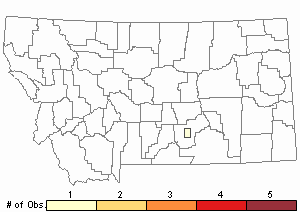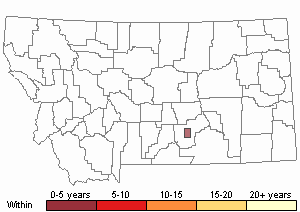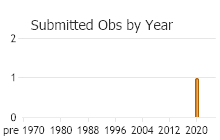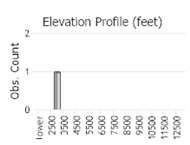View in other NatureServe Network Field Guides
NatureServe
Montana
Utah
Wyoming
Idaho
Wisconsin
British Columbia
South Carolina
Yukon
California
New York
Sprinkled Broad-winged Grasshopper - Chloealtis conspersa
Other Names:
Sprinkled Locust
General Description
The following comes from Brooks (1958), Helfer (1971), Otte (1981), Capinera and Sechrist (1982), Vickery and Kevan (1985), McDaniel (1987), Capinera et al. (2004), and Scott (2010). This small to medium size species exhibits sexual dimorphism between males and females. Males have totally black lateral lobes on the pronotum, and the dorsal disk is pale brown or straw-colored. The wings (tegmina) are bluntly round and expanded at the tips, which do not extend to the tip of abdomen. Females do not have black on the lateral sides of the pronotum. The wings are short and conspicuously speckled, reaching only to the 4th abdominal segment.
Phenology
Overwinters in the egg stage in rotting wood. Adults occur from July through September (Otte 1981, and Vickery and Kevan 1985).
Diagnostic Characteristics
The following is taken from Brooks (1958), Helfer (1971), Otte (1981), Capinera and Sechrist (1982), Vickery and Kevan (1985), McDaniel (1987), Capinera et al. (2004), and Scott (2010). Body size in males is 15 mm to 20 mm, females 20 mm to 28 mm. Outer face of the hind femur in males is banded with gray and ivory, the medial area with an ivory or pale spot in the middle section. In females, the banding is indistinct. The hind knees are black, and the hind tibia is orange or red. The basal abdominal segments are black but fades toward the tip.
A congener with
Thomas’ Broad-winged Grasshopper (
Chloealtis abdominalis), which has no black on lateral lobes of pronotum nor on the abdominal segments.
Species Range
Montana Range
Range Descriptions

 Native
Native
Range Comments
Widely distributed from British Columbia eastward to Ontario and New England states, southward to the Carolinas and northern New Mexico, Texas and Oklahoma. In Montana, it has been found in 4 counties (Brooks 1958, Brust et al. 2008, Capinera et al. 2004, Capinera and Sechrist 1982, Otte 1984, Scott 2010, and Vickery and Kevan 1985).
Observations in Montana Natural Heritage Program Database
Number of Observations: 2
(Click on the following maps and charts to see full sized version)
Map Help and Descriptions
Relative Density

Recency



 (Observations spanning multiple months or years are excluded from time charts)
(Observations spanning multiple months or years are excluded from time charts)
Habitat
Found in dry, upland woodlands, thickets, edges of woods, fence lines, and bushy pastures, wherever there are old tree stumps and rotting wood for depositing eggs (Capinera and Sechrist (1982), and Vickery and Kevan 1985).
Food Habits
Primarily a grass feeder, favoring
Canada bluegrass (
Poa compressa), as well as some non-native species such as
orchard grass (
Dactylis glomerata),
Kentucky bluegrass (
Poa pratensis), and timothy (Capinera and Sechrist 1982, Otte 1984, and Vickery and Kevan 1985).
Reproductive Characteristics
This species lays its egg in rotting wood. Holes are usually made 0.75 inch (about 19 mm) deep. The female will oviposit in soil or dung if wood is not available. Ten to fourteen eggs are in a pod. The nymphs pass through 5 instars before reaching the adult stage (Capinera and Sechrist 1982, and Vickery and Kevan 1985).
Stewardship Responsibility
References
- Literature Cited AboveLegend:
 View Online Publication
View Online Publication Brooks, A.R. 1958. Acridoidea of Southern Alberta, Saskatchewan, and Manitoba (Orthoptera). The Canadian Entomologist (Supplement 9) 90:5-92.
Brooks, A.R. 1958. Acridoidea of Southern Alberta, Saskatchewan, and Manitoba (Orthoptera). The Canadian Entomologist (Supplement 9) 90:5-92. Brust, M.L, W.W. Hoback, and R.J. Wright. 2008. The Grasshoppers of Nebraska. Lincoln, NB: University of Nebraska Extension Service, APHIS.
Brust, M.L, W.W. Hoback, and R.J. Wright. 2008. The Grasshoppers of Nebraska. Lincoln, NB: University of Nebraska Extension Service, APHIS. Capinera, J.L. and T.S. Sechrist. 1982. Grasshoppers of Colorado: Identification, Biology, and Management. Fort Collins, CO: Colorado State University Experiment Station, Bulletin 584S. 161 p.
Capinera, J.L. and T.S. Sechrist. 1982. Grasshoppers of Colorado: Identification, Biology, and Management. Fort Collins, CO: Colorado State University Experiment Station, Bulletin 584S. 161 p. Capinera, J.L., R.D. Scott, and T.J. Walker. 2004. Field Guide to Grasshoppers, Katydids, and Crickets of the United States. Ithaca, NY. Cornell University Press.
Capinera, J.L., R.D. Scott, and T.J. Walker. 2004. Field Guide to Grasshoppers, Katydids, and Crickets of the United States. Ithaca, NY. Cornell University Press. Helfer, J.R. 1971. How to Know the Grasshoppers, Crickets, Cockroaches, and Their Allies. Revised edition (out of print), Mineola, NY: Dover Publications.
Helfer, J.R. 1971. How to Know the Grasshoppers, Crickets, Cockroaches, and Their Allies. Revised edition (out of print), Mineola, NY: Dover Publications. McDaniel, B. 1987. Grasshoppers of South Dakota. Brookings, SD: South Dakota Agricultural Experiment Station, Bulletin TB 89.
McDaniel, B. 1987. Grasshoppers of South Dakota. Brookings, SD: South Dakota Agricultural Experiment Station, Bulletin TB 89. Otte, Daniel. 1981. The North American Grasshoppers. Volume 1. Acrididae (Gomphocerinae and Acridinae). Harvard University Press. 275 pp.
Otte, Daniel. 1981. The North American Grasshoppers. Volume 1. Acrididae (Gomphocerinae and Acridinae). Harvard University Press. 275 pp. Scott, R.D. 2010. Montana Grasshoppers, Katydids, and Crickets A Pictorial Field Guide to the Orthoptera. MagpieMTGraphics, Billings, MT.
Scott, R.D. 2010. Montana Grasshoppers, Katydids, and Crickets A Pictorial Field Guide to the Orthoptera. MagpieMTGraphics, Billings, MT. Vickery, V. R. and D. K. M. Kevan. 1985. The grasshopper, crickets, and related insects of Canada and adjacent regions. Biosystematics Research Institute, Ottawa, Ontario. Publication Number 1777. 918 pp.
Vickery, V. R. and D. K. M. Kevan. 1985. The grasshopper, crickets, and related insects of Canada and adjacent regions. Biosystematics Research Institute, Ottawa, Ontario. Publication Number 1777. 918 pp.
- Additional ReferencesLegend:
 View Online Publication
View Online Publication
Do you know of a citation we're missing? Bland, R.G. 2003. The Orthoptera of Michigan—Biology, Keys, and Descriptions of Grasshoppers, Katydids, and Crickets. East Lansing, MI: Michigan State University Extension, Bulletin E-2815. 221 p.
Bland, R.G. 2003. The Orthoptera of Michigan—Biology, Keys, and Descriptions of Grasshoppers, Katydids, and Crickets. East Lansing, MI: Michigan State University Extension, Bulletin E-2815. 221 p. Kirk, K. and C.R. Bomar. 2005. Guide to the grasshoppers of Wisconsin. Madison, WI: Wisconsin Department of Natural Resources, Bureau of Integrated Science Services PUB-SS-1008. 154 p.
Kirk, K. and C.R. Bomar. 2005. Guide to the grasshoppers of Wisconsin. Madison, WI: Wisconsin Department of Natural Resources, Bureau of Integrated Science Services PUB-SS-1008. 154 p.
- Web Search Engines for Articles on "Sprinkled Broad-winged Grasshopper"
- Additional Sources of Information Related to "Insects"





